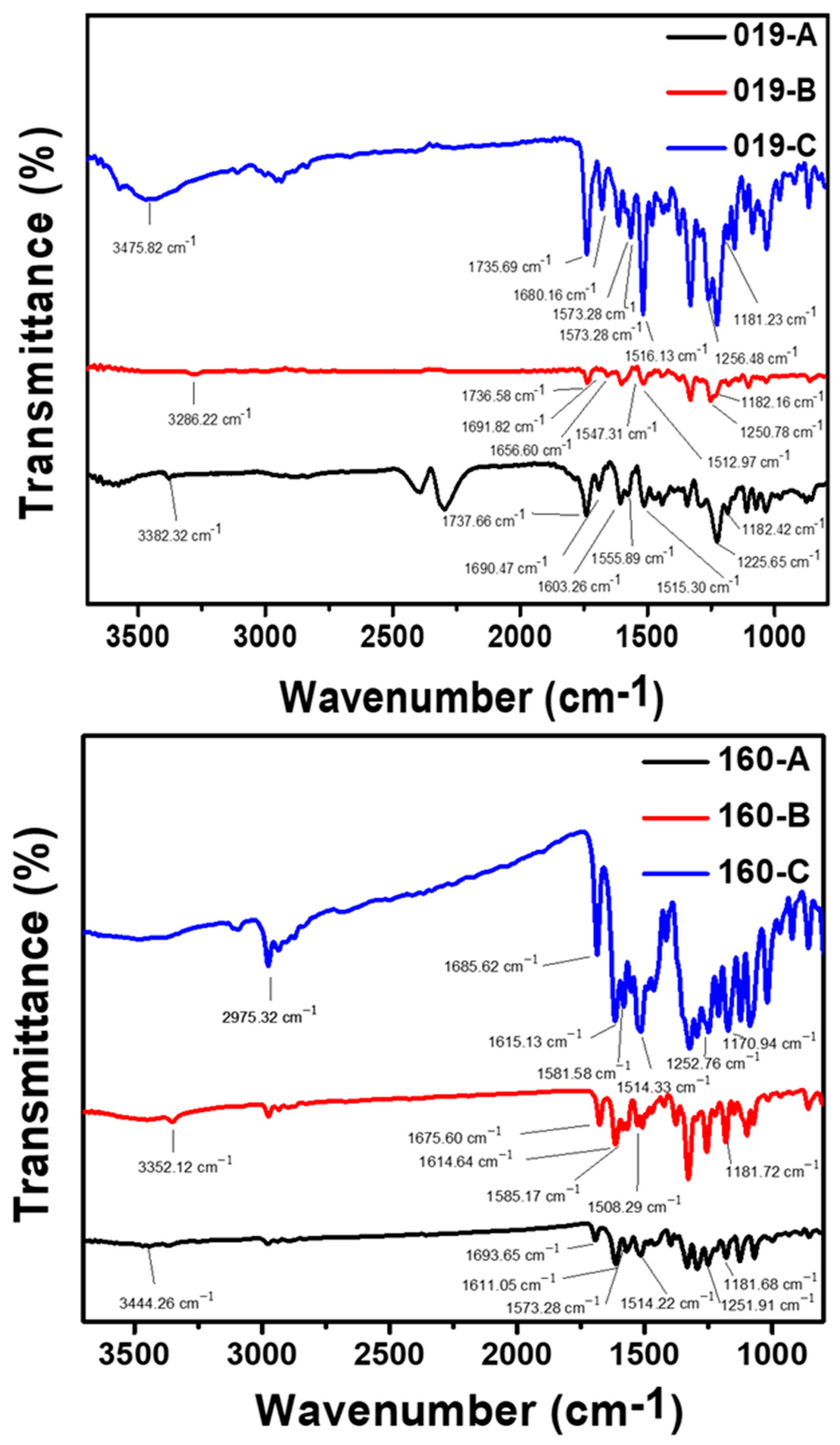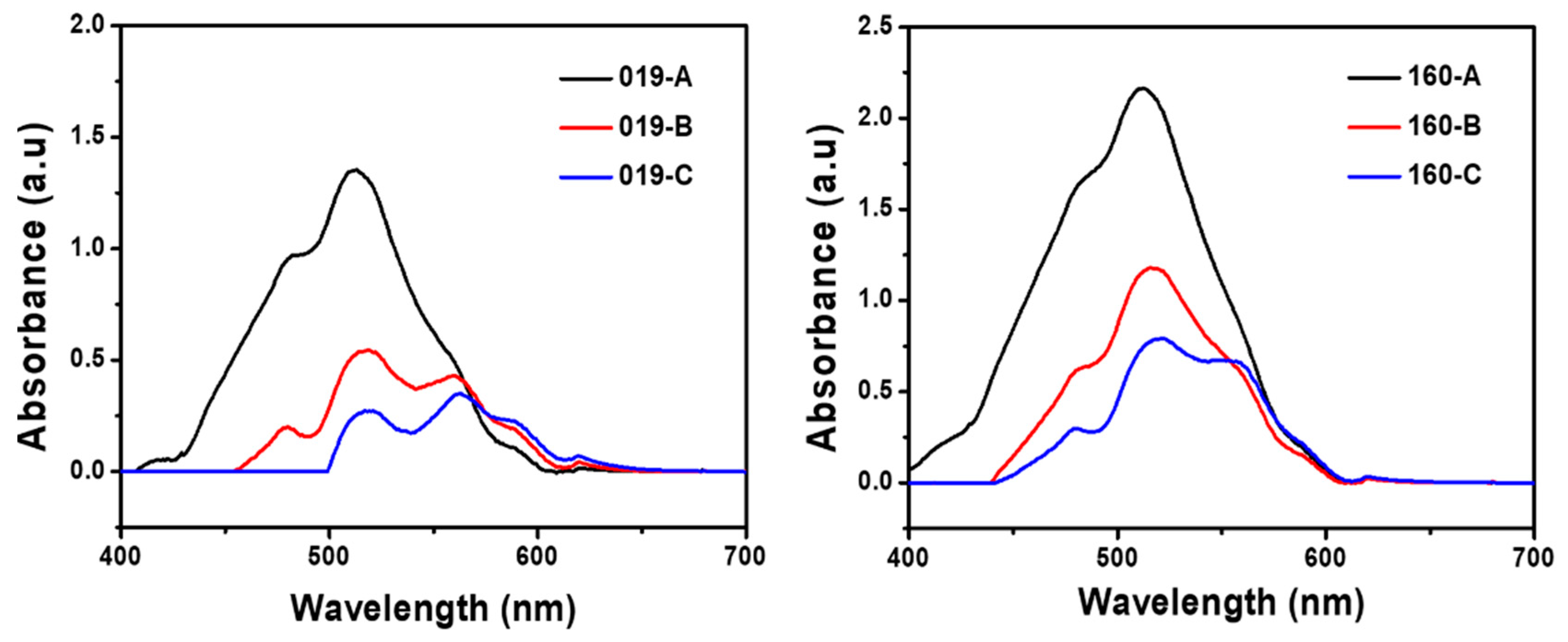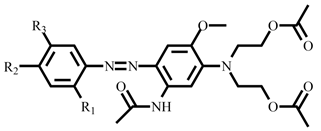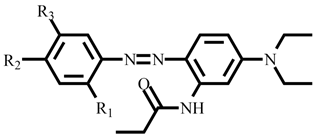Synthesis of Azo Disperse Dyes with High Absorption for Efficient Polyethylene Terephthalate Dyeing Performances in Supercritical Carbon Dioxide
Abstract
:1. Introduction
2. Experimental Process
2.1. Materials
2.2. Preparation of Dye
2.2.1. Diazonium Solution Preparation
2.2.2. Dye Fabrication and Purification
2.3. Characterization
2.4. Dyeing
2.5. Coloring Performance Characterization
2.6. Dyeing Fastness
2.7. Water Fastness
2.8. Perspiration Fastness
2.9. Color Fastness Abrasion and Rubbing
3. Results and Discussion
3.1. Dyes Synthesis and Characterization
3.2. Optical Characterization of Dyes
3.3. Dyeing Performances
3.3.1. Apparent Colorfastness K/S
3.3.2. Color Fastness Properties
4. Conclusions
Supplementary Materials
Author Contributions
Funding
Institutional Review Board Statement
Informed Consent Statement
Data Availability Statement
Acknowledgments
Conflicts of Interest
References
- Hou, A.; Chen, B.; Dai, J.; Zhang, K. Using supercritical carbon dioxide as solvent to replace water in polyethylene terephthalate (PET) fabric dyeing procedures. J. Clean. Prod. 2010, 18, 1009–1014. [Google Scholar] [CrossRef]
- Weber, E.J.; Adams, R.L. Chemical- and sediment- mediated reduction of the azo dye disperse blue 79. Environ. Sci. Technol 1995, 29, 1163–1170. [Google Scholar] [CrossRef]
- Gebert, B.; Saus, W.; Knittel, D.; Buschmann, H.J.; Schollmeyer, E. Dyeing natural fibers with disperse dyes in supercritical carbon dioxide. Text. Res. J. 1994, 64, 371. [Google Scholar] [CrossRef]
- Özcan, A.S.; Clifford, A.A.; Bartle, K.D.; Lewis, D.M. Dyeing of cotton fibres with disperse dyes in supercritical carbon dioxide. Dye. Pigment. 1998, 36, 103–110. [Google Scholar] [CrossRef]
- Zheng, H.; Zhang, J.; Yan, J.; Zheng, L. An industrial scale multiple supercritical carbon dioxide apparatus and its eco-friendly dyeing production. J. CO2 Util. 2016, 16, 272–281. [Google Scholar] [CrossRef]
- Park, G.; Kown, D.E.; Kong, W.; Park, J.; Lee, Y.W. A dissolution kinetic study of disperse dye in supercritical carbon dioxide to design an efficient supercritical dyeing process. Processes 2021, 9, 977. [Google Scholar] [CrossRef]
- Abou Elmaaty, T.; Abd El-Aziz, E. Supercritical carbon dioxide as a green media in textile dyeing: A review. Text. Res. J. 2017, 88, 1184–1212. [Google Scholar] [CrossRef]
- Park, S.C.; Tuma, D.; Kim, S.; Lee, Y.R.; Shun, J.J. Sorption of C. I. disperse red 60 in polystyrene and PMMA films and polyester and nylon 66 textiles in the presence of supercritical carbon dioxide. Korean J. Chem. Eng. 2010, 27, 299–309. [Google Scholar] [CrossRef]
- Bai, T.; Kobayashi, K.; Tamura, K.; Jun, Y.; Zheng, L. Super critical CO2 dyeing for nylon, acrylic, polyester, and casein buttons and their optimum dyeing conditions by design of experiments. J. CO2 Util. 2019, 33, 253–261. [Google Scholar] [CrossRef]
- Fernandez Cid, M.V.; Van Spronsen, J.; Van Der Kraan, M.; Veugelers, W.J.T.; Woerlee, G.F.; Witkamp, G.J. A significant approach to dye cotton in supercritical carbon dioxide with fluorotriazine reactive dyes. J. Supercrit. Fluids 2007, 40, 477–484. [Google Scholar] [CrossRef]
- Qian, H.F.; Song, X.Y. The structure of azo disperse dyes and its distribution on polyurethane fiber blend with polyester, or polyamide fiber. Dye. Pigm. 2007, 74, 672–676. [Google Scholar] [CrossRef]
- Zheng, H.; Xu, Y.; Zhang, J.; Xiong, X.; Yan, J.; Zheng, L. An ecofriendly dyeing of wool with supercritical carbon dioxide fluid. J. Clean. Prod. 2017, 143, 267–277. [Google Scholar] [CrossRef]
- Corak, I.; Tarbuk, A.; Dordevic, D.; Visic, K.; Botteri, L. Sustainable alkaline hydrolysis of polyester fabric at low temperature. Materials 2022, 15, 1530. [Google Scholar] [CrossRef]
- Liang, F.C.; Kuo, C.C.; Chen, B.Y.; Cho, C.J.; Hung, C.C.; Chen, W.C.; Borsali, R. RGB-switchable porous electrospun nanofiber chemosensor-filter prepared from multifunctional copolymers and their versatile sensing for pH and heavy metal. ACS Appl. Mater. Interfaces 2017, 9, 16381–16396. [Google Scholar] [CrossRef]
- Ketema, A.; Worku, A. Review on intermolecular forces between dyes used for polyester dyeing and polyester fiber. J. Chem. 2020, 2020, 7. [Google Scholar] [CrossRef]
- Abd-El-Aziz, A.S.; Afifi, T.H. Novel azo disperse dyes derived from aminothiophenes: Synthesis and UV-visible studies. Dye. Pigm. 2006, 70, 8–17. [Google Scholar] [CrossRef]
- De Giorgi, M.R.; Cadoni, E.; Maricca, D.; Piras, A. Dyeing polyester fibres with disperse dyes in supercritical CO2. Dye. Pigm. 2000, 45, 75–79. [Google Scholar] [CrossRef]
- Cardozo-Filho, L.; Mazzer, H.R.; Santos, J.C.; Andreaus, J.; Feihrmann, A.C.; Beninca, C.; Cabral, V.F.; Zanoelo, E.F. Dyeing of polyethylene terephthalate fibers with a disperse dye in supercritical carbon dioxide. Text. Res. J. 2014, 84, 1279–1287. [Google Scholar] [CrossRef]
- He, C.L.; Liang, F.C.; Veeramuthu, L.; Cho, C.J.; Benas, J.S.; Tzeng, Y.R.; Tseng, Y.L.; Chen, W.C.; Rwei, A.; Kuo, C.-C. Super tough and spontaneous water-assisted autonomous self-healing elastomer for underwater wearable electronics. Adv. Sci. 2021, 8, 2102275. [Google Scholar] [CrossRef]
- Park, K.S.; Kim, D. Determination of diffusion and mass transfer coefficients during drying of solvent-absorbed polymer films. Polym. J. 2000, 32, 415–421. [Google Scholar] [CrossRef] [Green Version]
- Xie, K.; Hou, A.; Sun, Y. Chemical graft of cellulose with the ion-pair emulsion containing the reactive groups and its dyeing properties. J. Dispers. Sci. Technol. 2008, 29, 1385–1390. [Google Scholar] [CrossRef]
- Sicardi, S.; Manna, L.; Banchero, M. Diffusion of disperse dyes in PET films during impregnation with a supercritical fluid. J. Supercrit. Fluids 2000, 17, 187–194. [Google Scholar] [CrossRef]
- Benkhaya, S.; M’rabet, S.; El Harfi, A. Classifications, properties, recent synthesis and applications of azo dyes. Heliyon 2020, 6, e03271. [Google Scholar] [CrossRef] [Green Version]
- Qiu, J.; Tang, B.; Ju, B.; Zhang, S.; Jin, X. Clean synthesis of disperse azo dyes based on peculiar stable 2,6-dibromo-4-nitrophenyl diazonium sulfate. Dye. Pigm. 2020, 173, 107920. [Google Scholar] [CrossRef]
- Jie, S.; Chunlin, Z.; Hökelek, T. X-ray crystal structure analysis for CI disperse orange 61. Color. Technol. 2012, 128, 91–94. [Google Scholar] [CrossRef]
- Qiu, J.; Xiao, J.; Tang, B.; Ju, B.; Zhang, S. Facile synthesis of novel disperse azo dyes with aromatic hydroxyl group. Dye. Pigm. 2019, 160, 524–529. [Google Scholar] [CrossRef]
- Feng, G.; Qian, H.F.; Bai, G.; Liu, Y.C.; Hu, L.L. Synthesis, characterization, and applications of diester/diurethane tethered azo disperse dyes: A new strategy to improve dye’s fastness properties. Dye. Pigm. 2016, 129, 54–59. [Google Scholar] [CrossRef]
- Asiagwu, A.K.; Otutu, O.J. Synthesis and application to polyester and nylon 6 fabrics of hetaryl bis-azo disperse dyes based on 6-amino-2,4-dihydroxypyrimidine and 4-methoxy-2-nitroaniline moieties. J. Sci. Res. 2019, 11, 215–224. [Google Scholar] [CrossRef]
- Shaki, H. Color, fastness, antibacterial, and skin sensitivity properties of high lightfastness azo disperse dyes incorporating sulfamide groups. Fibers Polym. 2020, 21, 2530–2538. [Google Scholar] [CrossRef]
- Tang, P.; Feng, Y.; Li, D. Fabrication and properties of acid blue 25 dye-intercalated layered double hydroxides film on an anodic alumina/aluminum substrate. J. Phys. Chem. Solids 2012, 73, 1505–1509. [Google Scholar] [CrossRef]
- El Ghoul, Y.; Martel, B.; El Achari, A.; Campagne, C.; Razafimahefa, L.; Vroman, I. Improved dyeability of polypropylene fabrics finished with β-cyclonedextrin-citric acid polymer. Polym. J. 2010, 42, 804–811. [Google Scholar] [CrossRef] [Green Version]
- Popa, S.; Radulescu-Grad, M.E.; Perdivara, A.; Mosoarca, G. Aspects regarding colour fastness and adsorption studies of a new azo-stilbene dye for acrylic resins. Sci. Rep. 2021, 11, 5889. [Google Scholar] [CrossRef]
- Kubelka, P.; Munk, F. An article on optics of paint layers. Fuer Tekn. Phys. 1931, 12, 593–609. [Google Scholar]
- Li, M.; Huang, Y.; Yu, T.; Chen, S.; Ju, A.; Ge, M. Chemical recylcing of waste poly(ethylene terephthalate) fibers into azo disperse dyestuffs. RSC Adv. 2014, 4, 46476–46480. [Google Scholar] [CrossRef]
- Kurade, M.B.; Waghmode, T.R.; Jadhav, M.U.; Jeon, B.-H.; Govindar, S.P. Bacterial-yeast consortium as an effective biocatalyst for biodegradation of sulphonated azo dye Reactive Red 198. RSC Adv. 2015, 5, 23046. [Google Scholar] [CrossRef]
- Cinar, M.; Coruh, A.; Karabacak, M. A comparative study of selected disperse azo dye derivatives based on spectroscopic (FT-IR, NMR and UV-Vis) and nonlinear optical behaviors. Spectrochim. Acta Part A 2014, 122, 682–689. [Google Scholar] [CrossRef]
- Kim, J.P.; Kim, J.S.; Park, J.S.; Jang, S.S.; Lee, J.J. Synthesis of temporarily solubilised azo disperse dyes containing a β-sulphatoethylsulphonyl group and dispersant-free dyeing of polyethylene terephthalate fabric. Color. Technol. 2016, 132, 368–375. [Google Scholar] [CrossRef]
- Grishanov, S. Structure and properties of textile materials. In Handbook of Textile and Industrial Dyeing; Clark, M., Ed.; Principles. Processes and Types of Dyes; Woodhead Publishing Limited: Cambridge, UK, 2011; Volume 1, pp. 28–36. [Google Scholar]
- Richards, P.R. Fabric Finishing: Dyeing and Colouring. In Textiles and Fashion. Materials. Design and Technology; Sinclair, R., Ed.; Woodhead Publishing Limited: Cambridge, UK, 2015; pp. 475–505. [Google Scholar]
- Elsherbiny, A.S.; Salem, M.A.; Ismail, A.A. Influence of the alkyl chain length of cyanine dyes on their adsorption by Na+-montmorillonite from aqueous solutions. Chem. Eng. J. 2012, 200–202, 283–290. [Google Scholar] [CrossRef]
- Lu, L.; He, L.; Zhang, S.; Freeman, H.S. Novel yellow azo-anthraquinone dyes for polylactide fibres: Effects of alkyl chains length. Color. Technol. 2012, 128, 121–126. [Google Scholar] [CrossRef]
- Zolinger, H. Color Chemistry: Syntheses, Properties and Applications of Organic Dyes and Pigments, 1st ed.; VCH: Weinheim, Germany, 1987; Chapter 7. [Google Scholar]
- Hong, C. Research on the Synthesis of Azo Dyes of Aminophenol Compounds and G-Acid. Master’s Thesis, Institute of Chemical Engineering, National Central University, Taipei, Taiwan, 2000. [Google Scholar]
- Huang, B. Dyeing Properties and Functions of Water-Repellent Dyes on PTT Fibers. Master’s Thesis, Institute of Textile Engineering, Feng Chia University, Taichung, Taiwan, 2004. [Google Scholar]
- Zhang, M. Research on Water Repellency of Fluoroalkyl Acid Dyes. Master’s Thesis, Institute of Textile Engineering, Feng Chia University, Taichung, Taiwan, 1990. [Google Scholar]
- Lai, J. Synthesis and Application of Water- and Oil-Repellent Superfine Polyester Fiber Dyes. Master’s Thesis, Institute of Organic Polymers, Taipei University of Technology, Taipei, Taiwan, 2001. [Google Scholar]
- Chen, R. Dyestuff Chemistry; Textile Industry Press: Beijing, China, 1989; pp. 39–58. [Google Scholar]
- He, J. Dyestuff Chemistry; China Textile Press: Beijing, China, 2004; pp. 30–39. [Google Scholar]



| Dye | R1 | R2 | R3 | General Structure | Mass | Molecular Formula | Yield |
|---|---|---|---|---|---|---|---|
| 019-A | CH3 | NO2 | OCH3 |  | 545.21 | C25H31N5O9 | 87% |
| 019-B | - | NO2 | - | 501.19 | C23H27N5O8 | 84.4% | |
| 019-C | OCH3 | NO2 | - | 531.20 | C24H29N5O9 | 83.7% | |
| 160-A | CH3 | NO2 | OCH3 |  | 413.21 | C21H27N5O4 | 81.5% |
| 160-B | - | NO2 | - | 369.18 | C19H23N5O3 | 78.7% | |
| 160-C | OCH3 | NO2 | - | 399.19 | C20H25N5O4 | 83.2% |
| Dye | Maximum Absorption Wavelength (nm) | Absorbance | Absorption Coefficient (L·mol−1·cm−1) | Log(e) |
|---|---|---|---|---|
| 019-A | 513 | 1.353535 | 135354 | 5.131 |
| 019-B | 519 | 0.544376 | 54437.6 | 4.736 |
| 019-C | 562 | 0.351125 | 35112.5 | 4.545 |
| 160-A | 512 | 2.162309 | 216231 | 5.335 |
| 160-B | 516 | 1.178727 | 117873 | 5.071 |
| 160-C | 522 | 0.792503 | 79250.3 | 4.899 |
| Dye | Apparent Color Density | Relative Color First Time |
|---|---|---|
| 019-A | 15.5170 | 89.49% |
| 019-B | 16.3760 | 89.30% |
| 019-C | 14.7890 | 90.15% |
| 160-A | 20.02 | 88.82% |
| 160-B | 18.9330 | 68.92% |
| 160-C | 16.7450 | 72.78% |
| Dye | Cellulose Acetate | Cotton | Nylon | Polyester | Acrylic | Wool |
|---|---|---|---|---|---|---|
| 019-A | 3–4 | 4 | 3–4 | 4–5 | 5 | 4–5 |
| 019-B | 4–5 | 4–5 | 4 | 4–5 | 4–5 | 4–5 |
| 019-C | 4–5 | 4–5 | 4 | 4–5 | 5 | 5 |
| 160-A | 4–5 | 4–5 | 4 | 4–5 | 5 | 5 |
| 160-B | 4–5 | 4 | 4 | 4 | 5 | 4–5 |
| 160-C | 4–5 | 5 | 4–5 | 4–5 | 5 | 5 |
| Dye | Cellulose Acetate | Cotton | Nylon | Polyester | Acrylic | Wool |
|---|---|---|---|---|---|---|
| 019-A | 4–5 | 4–5 | 4 | 4–5 | 4–5 | 4–5 |
| 019-B | 4 | 4–5 | 4 | 4–5 | 5 | 4–5 |
| 019-C | 4–5 | 4–5 | 4 | 4–5 | 5 | 4–5 |
| 160-A | 4–5 | 4–5 | 4 | 4–5 | 5 | 5 |
| 160-B | 4–5 | 4–5 | 4–5 | 4–5 | 5 | 5 |
| 160-C | 4–5 | 4–5 | 4–5 | 4–5 | 5 | 5 |
| Dye | Dry Friction | Wet Friction |
|---|---|---|
| 019-A | 4 | 4–5 |
| 019-B | 4 | 4–5 |
| 019-C | 4 | 5 |
| 160-A | 4 | 4–5 |
| 160-B | 4 | 4–5 |
| 160-C | 4 | 4–5 |
Publisher’s Note: MDPI stays neutral with regard to jurisdictional claims in published maps and institutional affiliations. |
© 2022 by the authors. Licensee MDPI, Basel, Switzerland. This article is an open access article distributed under the terms and conditions of the Creative Commons Attribution (CC BY) license (https://creativecommons.org/licenses/by/4.0/).
Share and Cite
Cheng, Y.-W.; Benas, J.-S.; Liang, F.-C.; Lin, S.-M.; Sun, T.-W.; Liu, F.-C.; Yu, Y.-Y.; Kuo, C.-C. Synthesis of Azo Disperse Dyes with High Absorption for Efficient Polyethylene Terephthalate Dyeing Performances in Supercritical Carbon Dioxide. Polymers 2022, 14, 3020. https://doi.org/10.3390/polym14153020
Cheng Y-W, Benas J-S, Liang F-C, Lin S-M, Sun T-W, Liu F-C, Yu Y-Y, Kuo C-C. Synthesis of Azo Disperse Dyes with High Absorption for Efficient Polyethylene Terephthalate Dyeing Performances in Supercritical Carbon Dioxide. Polymers. 2022; 14(15):3020. https://doi.org/10.3390/polym14153020
Chicago/Turabian StyleCheng, Yu-Wen, Jean-Sebastien Benas, Fang-Cheng Liang, Shang-Ming Lin, Ting-Wang Sun, Fu-Chieh Liu, Yang-Yen Yu, and Chi-Ching Kuo. 2022. "Synthesis of Azo Disperse Dyes with High Absorption for Efficient Polyethylene Terephthalate Dyeing Performances in Supercritical Carbon Dioxide" Polymers 14, no. 15: 3020. https://doi.org/10.3390/polym14153020
APA StyleCheng, Y.-W., Benas, J.-S., Liang, F.-C., Lin, S.-M., Sun, T.-W., Liu, F.-C., Yu, Y.-Y., & Kuo, C.-C. (2022). Synthesis of Azo Disperse Dyes with High Absorption for Efficient Polyethylene Terephthalate Dyeing Performances in Supercritical Carbon Dioxide. Polymers, 14(15), 3020. https://doi.org/10.3390/polym14153020







